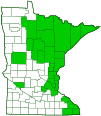skunk cabbage
(Symplocarpus foetidus)
Conservation • Wetland • Description • Habitat • Ecology • Use • Distribution • Taxonomy
Description |
||
|
||
Height |
||
12″ to 24″ |
||
Flower Color |
||
Green flowers on a purple green to spadix inside a purple hood |
||
Similar Species |
||
Habitat |
||
Wet. Marshes, swamps. Full or partial shade. |
||
Ecology |
||
Flowering |
||
March to May |
||
Pests and Diseases |
||
|
||
Use |
||
|
||
Distribution |
||||
|
Sources |
|||
| 6/16/2023 | ||||
Nativity |
||||
Native |
||||
Occurrence |
||||
|
||||
Taxonomy |
|||
| Kingdom | Plantae (Plants) | ||
| Division | Tracheophyta (Vascular Plants) | ||
| Subdivision | Spermatophytina (Seed Plants) | ||
| Class | Liliopsida (Monocots) | ||
| Subclass | Alismatidae | ||
Order |
Alismatales (aroids, water-plantains, seagrass, and allies) | ||
Family |
Araceae (arum) | ||
| Subfamily | Orontioideae | ||
Genus |
Symplocarpus (skunk cabbages) | ||
Synonyms |
|||
Spathyema foetida |
|||
Common Names |
|||
eastern skunk cabbage skunk cabbage |
|||
Visitor Photos |
|||||
Share your photo of this plant. |
|||||
| This button not working for you? Simply email us at info@MinnesotaSeasons.com. Attach one or more photos and, if you like, a caption. |
|||||
|
|||||
MinnesotaSeasons.com Photos |
|||||
Plant |
|||||
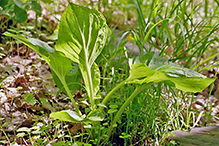 |
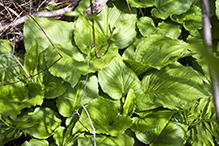 |
||||
Flower |
|||||
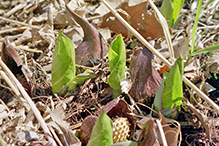 |
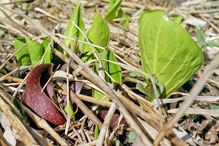 |
||||

Slideshows |
||
| Symplocarpus foetidus Zi W |
||

|
||
| A Wild Skunk Cabbage Blooms Phil Pursley |
||
About
Uploaded on Apr 22, 2011 The Symplocarpus foetidus (Eastern Skunk Cabbage) emerges through the snow and ice of an Illinois forest (Goodenow Grove, Will County Forest Preserve District, Beecher, IL) to blossum for all to enjoy. This plant shows an amazing ability to generate its own heat (thermogenesis), anywhere from 65 to 95 degrees F. |
||

Visitor Videos |
|||
Share your video of this plant. |
|||
| This button not working for you? Simply email us at info@MinnesotaSeasons.com. Attach a video, a YouTube link, or a cloud storage link. |
|||
Other Videos |
|||
| Skunk Cabbage - A Sign of Spring [Plant ID Guide] BlackOwlOutdoors |
|||
About
Published on Mar 1, 2013 Krik of Black Owl Outdoors talks about Skunk Cabbage [Symplocarpus foetidus] a hearty plant that is an indicator of spring's impending return. A reason the Skunk Cabbage is able to sprout so early is because of thermogenesis, the ability to generate its own heat. The Skunk Cabbage can melt snow around it and use it's heat to spread it's smell and attract pollinators such as flys and beetles. The Skunk Cabbage has a wide range of population, spanning from eastern Asia to Eastern North America, but is found in wet, low-lying, boggy areas. |
|||
| ザゼンソウ(座禅草、Symplocarpus foetidus) clothoid |
|||
About
Uploaded on Feb 27, 2010 群馬県前橋市富士見町沼の窪のザゼンソウ群生地 2010年2月27日撮影 |
|||
| Eastern Skunk Cabbage MrILoveTheAnts |
|||
About
Uploaded on Feb 23, 2012 Eastern Skunk Cabbage, Symplocarpus foetidus, is one of the earliest plants to flower. It's an important sources of early pollen for pollinators, mainly carrion flies, beetles, and early bees. The flower shields the insects from the cold and often they'll spend the night within the flower. Occasionally this kills the pollinator but I've found most of the flowers rot or are damaged enough that escape is easy. This plant normally grows in mucky bog-like soil in wetlands and along creeks and streams. |
|||

Visitor Sightings |
|||||
Report a sighting of this plant. |
|||||
| This button not working for you? Simply email us at info@MinnesotaSeasons.com. Be sure to include a location. |
|||||
| Katie 3-13-2018 |
Location: Minnehaha Regional Park (4801 S Minnehaha Dr, Minneapolis, MN 55417) Sighted three years in a row in wet areas between falls and confluence of Minnehaha Creek and Mississippi River, take the path on the south side of the creek that alternates between boardwalk and beaten soil path. Is currently blooming. |
||||
MinnesotaSeasons.com Sightings |
|||||

|
Created: Last Updated: © MinnesotaSeasons.com. All rights reserved. |
